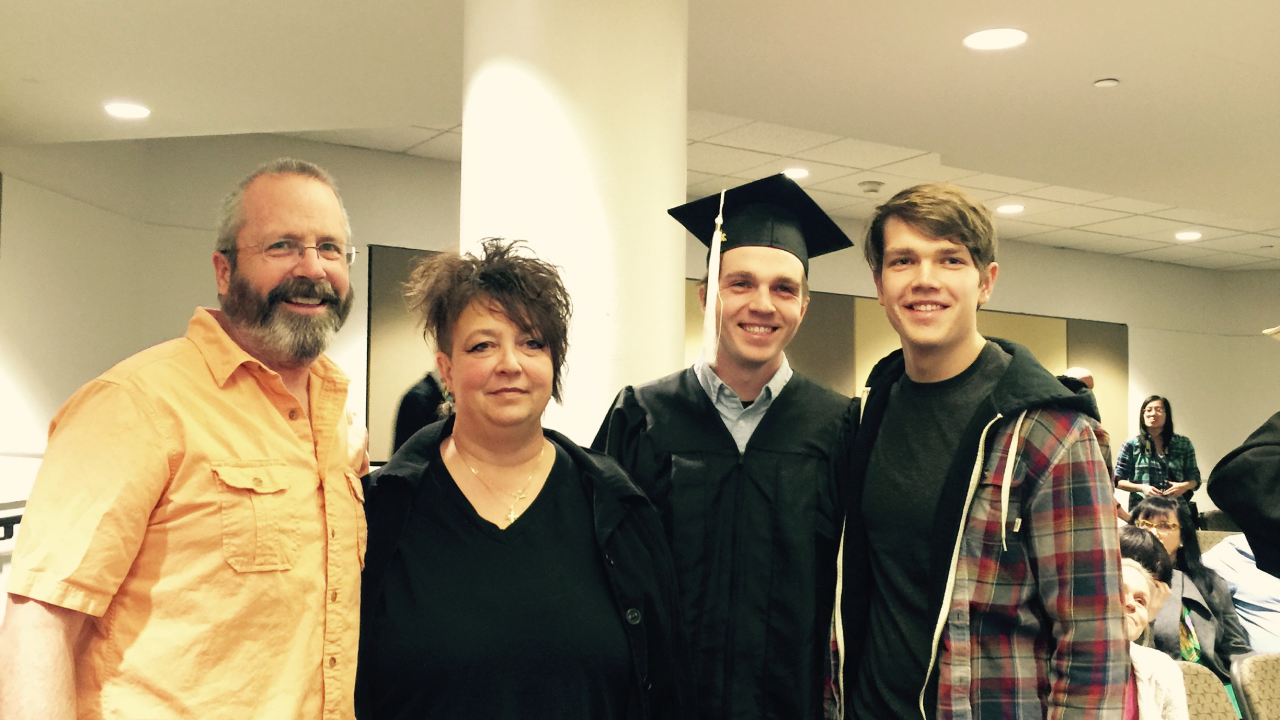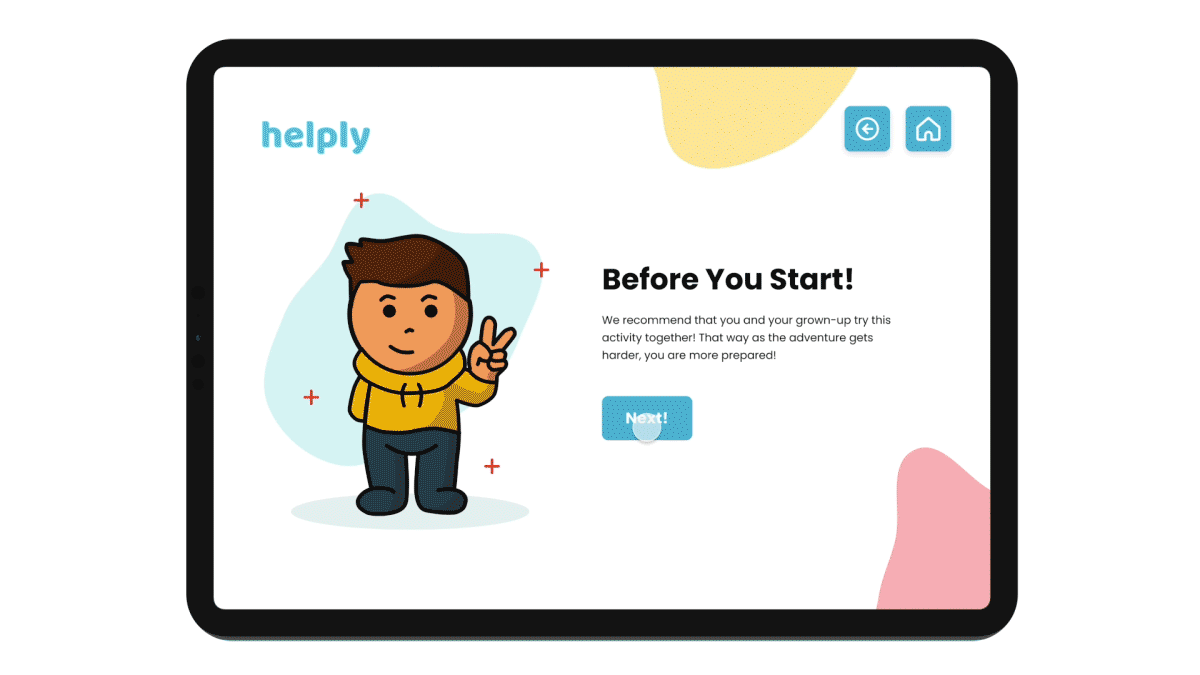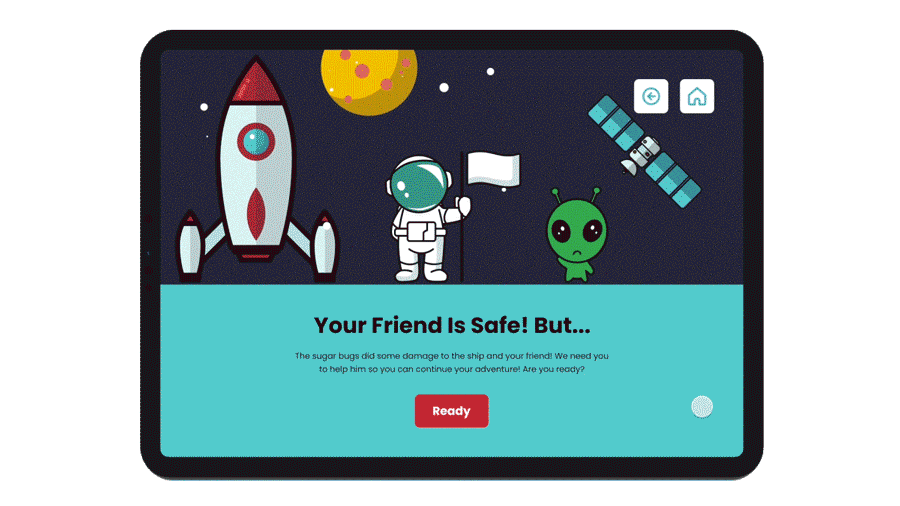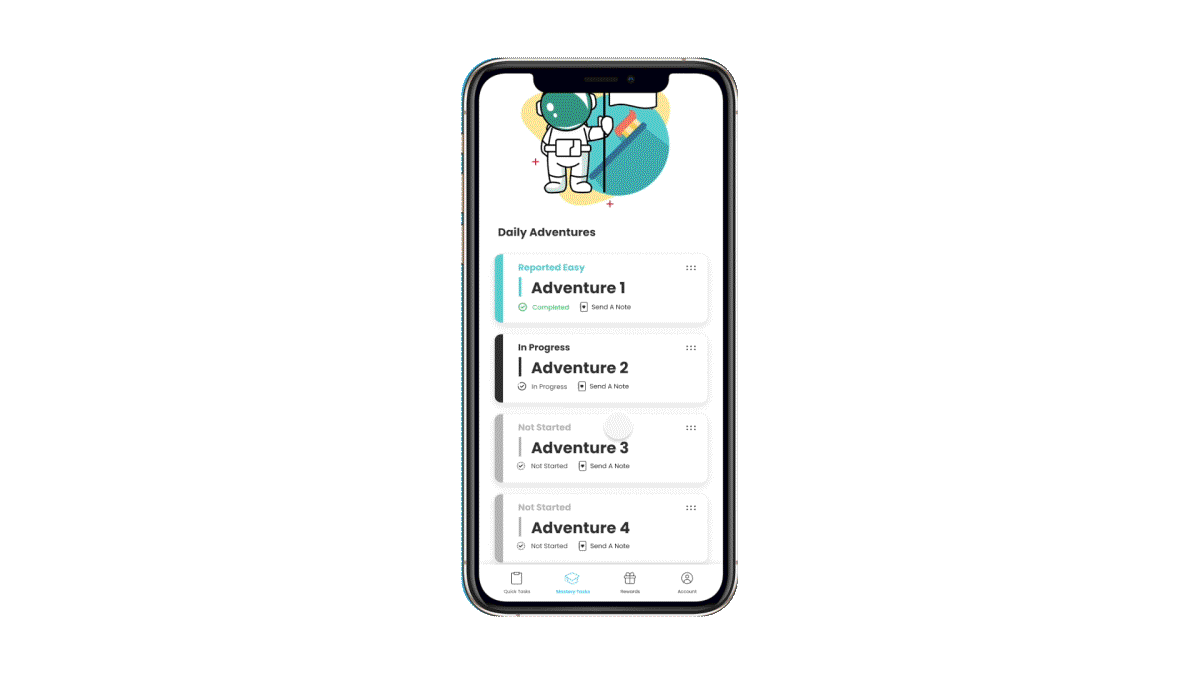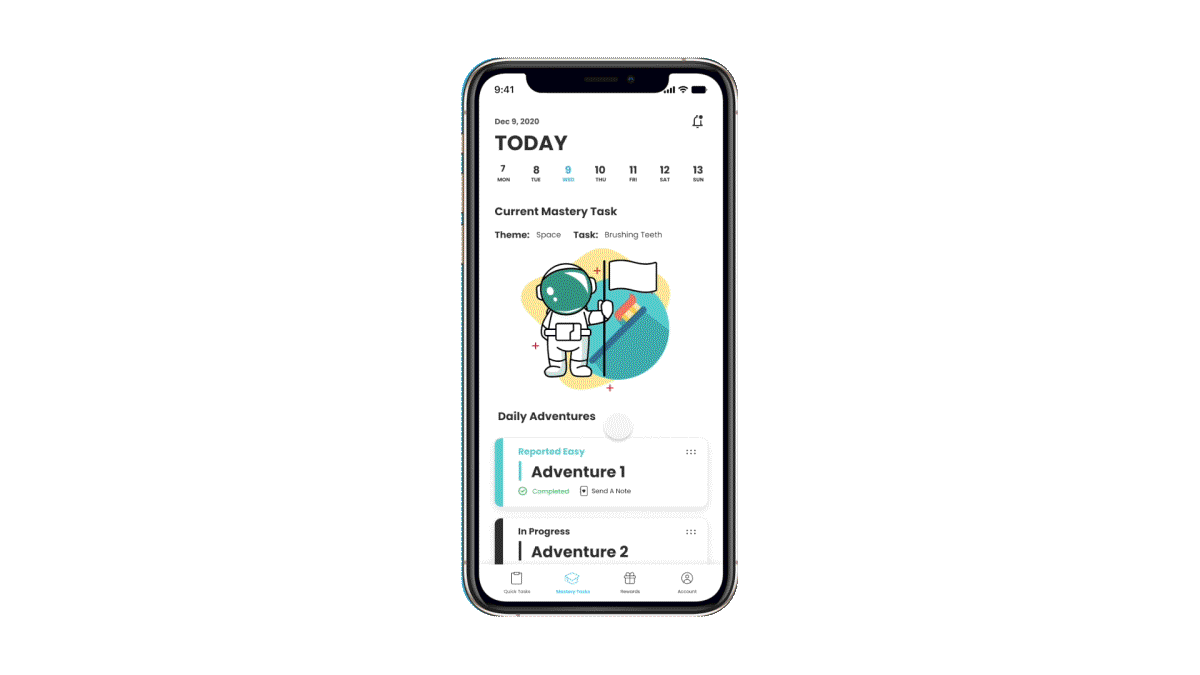Helply
COVID has ripped guardians' and children's routines, resources, and support systems from their lives. There is a need for assisting families and their struggle to juggle compounding responsibilities and roles. In response to this, we created Helply, a way for children to take ownership and master tasks on their own, reducing the stress of the guardian by separating their constant requirement in their child's life while also empowering the child by giving them agency in their own lives.
Summary
Helply resulted from a ten-week project at the University of Washington Human-Computer Interaction and Design program in Seattle. We were given the initial problem around the home during COVID and the difficulties with a fully remote world. Our team developed a three-part system that helps children, ages 6-8, master skills and took on responsibility within the home through this lens. The impact of this project is to assist guardians with newfound roles and duties that COVID and a remote setting have forced upon them by helping children take ownership and responsibility for some of their tasks and responsibilities around the house.
Specs
Project Type
Masters Project | Ideation Studio
My Contributions
Interaction Design, User Research, & Brand /Visual Design
Team
Nathan Keyes, Maisie Howard, & Angela Xu
Duration
10 weeks
Setting the scene
Because we caused them so much stress…
For most of us, we were raised by some form of a parental figure. As kids, we aren't usually the ones that handle worrying about the big things in life because we have someone looking out for us from the moment we enter this world. As children, we don't recognize how hard being a guardian truly is. However, as we get older and maybe reflect on our childhoods, we begin to see just truly how unique our guardians are. Although none of us on the team were or are parents, we assumed that guardians' responsibilities have always been very demanding and time-intensive. As a team, we had the assumption that guardians' jobs have only become more challenging since the start of the pandemic… Our hunch was solid.
The Problem
In 2020 the COVID-19 pandemic has increased pressures on everyone’s lives, but how have parents and guardians fared in this new landscape?
01.
65% of guardians have had to adjust their personal and professional routines.
02.
43% of guardians have reported increased anxiety since the start of the pandemic.
03.
25% of guardians have reported increased feelings of depression.
Families are dealing with increased parental demands, changes in their routines, and increased roles that they have to take on beyond their previous experiences. Due to this shifting landscape, the normal forms of coping and problem-solving have been removed from their lives. Making all of these changes much more invasive.
Research
As a team, we utilized a few different research methods to verify our assumptions and truly better understand parental demands, social and emotional changes in children and adults, and resources that guardians used before the pandemic.
Stakeholder Mapping
We began by setting the scene with our ecosystem. In the beginning, we were attempting to think of all parts of the system that affect the guardians somehow. However, after digging deeper, we decided to only focus on the child to guardian relationship, learning that the landscape of third-party resources will constantly be changing with or without the pandemic. However, the child's role in the guardian's life is forever present.
Literature Review
To gain a better understanding of the problem space, we conducted a literature review around the psychological impacts of minimized socialization among children and their guardians. Beyond that, we looked into various methods when it comes to parental burnout during the pandemic. This led us toward assistive learning structures used when teaching children to be more independent during their formative years.
Contextual Inquiry
We wanted to gain a more holistic understanding of the environment we were making assumptions around. To test our hypotheses and observed themes, we conducted a contextual inquiry with four guardians and their children. Our goal with these interviews was to see how children and their guardians interacted with one another, what their physical environment looked like, and what problems they are facing at that very moment, coping mechanisms, or homemade solutions they are using to deal with these problems.
What we learned
Guardians rely on their partner and their child for support.
Guardians are becoming increasingly reliant on each other as their primary support system, while their external social networks have decreased drastically. Through this understanding that many of the external systems are gone, and for the foreseeable future, not coming back, we want to focus on what can be helped in the guardian’s home.
“... I had lots of great strong friendships and family relationships outside of the household that I leaned on. But then this pandemic really just shrank and collapsed that world ... I feel like [my husband] has now become much more of support because of that.” - P2
Guardians are forced to multitask at a rapid rate, resulting in mental fatigue.
Since the pandemic, guardians were tasked with many new things in their life. With the increased time spent with their children and the reduced support systems in their life, guardians have to manage and do so much more to keep everything on track. As a group, we aim to assist guardians with task switching through assisted prioritization (goal shifting & rule activation) and delegation to help reduce stress and anxiety associated with cognitive overload (task cost).
“While she's in class, trying to do my work at the same time, but then also trying to listen to what her teacher is saying, then also trying to gain keep an eye on my daughter to make sure that she's paying attention. So my brain split three different ways.” - P4
It's just very hard to keep. It's like I'm trying to shoot at a moving target. And like trying to shoot it like multiple moving targets all the time. It's very exhausting.” - P4
Guardians and their children have been in a constant state of crisis, with no end in sight.
In this time of crisis, guardians are finding themselves stuck in this perpetual state of stress and exhaustion and having feelings of hopelessness and cannot reach a point of healing and recovery. We hope to assist guardians stuck in the disillusionment phase who feel discouraged, stressed, and physically exhausted and help them reach the reconstruction phase. They have an overall feeling of recovery.
“Well this whole quarantine I have been in that okay okay okay mode with a few minor breakdowns and then the Fall came and school started and that's when I realized that I haven't had that moment of utter collapse into a heap, and I am obviously that I won't get that for a long time.” - P1
“But it feels like we're just kind of spiraling down and it's never gonna never going to get better.” - P5
The different types and amounts of roles the guardian must perform have increased, and are now clashing…
The number of tasks a guardian has had to take on increased, but the guardian's different roles must have increased as well. We aim to reduce the number of roles guardians have to take on in their household to mitigate face threats and decrease tensions associated with balancing these multiple roles.
“I'm not only there in her test manager, but I am also her teaching assistant. I'm her short-order cook. I'm the principal I'm a school counselor and those are things that I was not told and to anticipate doing.” - P4
“Sometimes I just have to snap at (her son), because how many times do you have to ask a kid to brush his teeth or go to bed, before you are just ready to like throw something across the room?” - P1
How Might We…. Provide children with a sense of responsibility and control over their environment, in order to assist primary caregivers, dealing with a constantly shifting environment?
Design Principles
Adapt to Environments
A solution that can adapt to the guardians’ needs as their landscape continues to change.
Reclaiming
Control
A solution that helps guardians regain a sense of control in their ability to manage their daily tasks.
Shifting Responsibilities
A solution that manages and shifts responsibilities within a family.
Fun
& Engaging
A solution that is fun and engaging to encourage the user to use the product.
Ideation
Not every idea is a good idea…
Once we were comfortable with our initial research findings and developed a How Might We and a set of design principles to build a concept out of, we decided to move into the ideation phase. In this phase, we went for quantity. We knew many biases and assumptions were still in our minds, and to filter the obvious ideas and even biased ideas, we wanted to come up with as many as possible. Each of us drew up 30+ concepts with our HMW in mind. Once we completed this exercise, we put our images together and began to affinitize them into themes emerging through our conversations around our ideas. We hoped to see if there were potential opportunity spaces even in our theoretical design concepts.
Once we put the ideas into groups, each of us read through them and compared them to our carefully curated design principles. We understood that when designing, we can get lost in the excitement of creating new things, but we also need to root our decisions in core values and research. We then worked through a dot sorting method that allowed us to vote on our favorite concepts. Although we had over 120 to choose from, we could widdle this down to five and then finally the one! We ended up picking a concept that addressed the space and got us all excited to work on it!
Prototyping and Testing
Gotta start somewhere.
As a team, we created Helply with three primary parts. A wearable and iPad game for the child, as well as an app for the guardian to track their progress. Beyond this, everything was very low fidelity. We knew our end goal was to help a child master a task while also giving the guardian a bit more control in their life. To do this, we created paper prototypes for each part of our concept.
We tested it!
For each of these flows, we tested the concept on a guardian and their child over zoom! Due to NDA’s and the protection of the participants and children, we had to scrub all of their data and delete any images taken during the sessions.
Through our tests, we were able to gain a lot of beneficial insights when it came to our product. We knew this would be a helpful exercise because when designing for guardians and children, all we could do as a group is assume that we need to verify those assumptions through user testing.
Insights
01.
Scaffolded learning approaches are key when teaching a child a new skill.
02.
In order for the child to have an interest in what they are doing, they need to be entertained.
03.
Guardians want to know what their kid is up to, and kids love to share what they have done!
04.
Children are less likely to do something if they are simply told what to do.
High Fidelity Prototype
Three-Part System
When designing Helply, we were working in a complex environment. The system we created can be cut into three parts; iPhone, iPad, and wearable. However, each section works towards solving many pain points along the journey we focused on as a team.
Customization
When we were designing Helply, we knew that guardians’ schedules and even resources change frequently, and the child’s preferences change even more regularly. I knew we needed a product that could shift and adapt to these preferences and needs of the users. For this, I designed the task section, reward section, and story section to have a lenient structure with the ability to customize materials for the task, the rewards themselves, and even the story that the child wants to pick.
“But if there’s a day that it wouldn’t work on him...and didn’t care about pizza or watching more TV...those things will just fly out that day.” - P2
Scaffolded Learning Approach
Customization will be the least of our worries if the child doesn’t learn how to complete the task they are trying to learn. To help this, I designed a scaffolded learning approach within the system itself. Although existing structures are out in the world, I decided to keep it simple within our product. I wanted to use the concept of modeling at the beginning of the week, and then I tried to add tips and hints for the child as they attempt the activities on their own. The goal of this was to provide children with enough support, in the beginning, to get the hang of it and then reduce the guardians’ involvement as the week moves on with in-game tips.
“Make sure to show the steps as you move forward so they know where they are going and what's to come.” - P1
Sharing
We saw that kids responded well to a show and tell method through our user testing—something where they could take pride in their accomplishments and show them off to their guardians. We also learned that guardians want to support their children, even from afar! They wanted to do this not only because they love their child but also that works of positive affirmation work amazingly when trying to get their child to do something. I designed a debrief section on the iPad that walks through the child's accomplishments with the guardian and even has a few exercises to work on together!
When he comes home and I’ll look in his backpack and he has all his crafts...and ill take them out one by one and be like “WOW who made this?” and he’ll be like “I did!!” and I would say, “this is great!” - P1
Caring
As for the guardian, we wanted to design a feature that would allow them to show encouragement while also preventing them from being a crutch for the child. In the guardian's app, they can send a voice memo when assigning a task to their child. The goal of this was to create a personal feedback and support system that extended beyond the "gamification" we designed previously. Beyond that, the guardian did want to keep tabs on their child, so I created a summary system showing their child's progress on a particular task and even past lessons. The goal of this was to allow the guardian to have a hidden presence in the child's learning, allowing them to work on their own and have outside assistance provided when needed.
“I would love to see charts of what he’s done. So maybe a report card of chores..to see that he’s thriving, that’s a good feeling.” - P2
Story-Driven and Fun!
During our user testing with our low fidelity prototype, we observed that the child's attention span is fleeting with all three participants. We were giving them a task to complete, on dull white paper, with only a few fun works indicating it's an "adventure." We knew we needed to keep their attention, but we just didn't know-how. Simply put, our participants and professor both thought of making it a story and adding fun characters and adventures to reduce the tedious nature of "chores." With this feedback, I created an illustration library and brand system that aims to be a friendly, kind, and simple visual system for the children while using Helply. The visual system used had a lot of inspiration from other children's applications, especially when designing the layout for pages and even small button designs. Because the project was only ten weeks, I needed a visual system that was simple but effective. All character illustrations were custom. However, we bought a pack of 10 flat lay icons and then custom-made the others fit what we needed.
Limitations
Chop it up to human error…
As a group, we designed a product in 10-weeks. We couldn’t be more proud of the work that went into this, however, we understand that our concept has serious limitations that need to be addressed if it were to be taken further. The design process is meant to be reflective, and honestly, if we thought we nailed it on our first go, that would be ignorant. Some of these limitations are in areas that we failed to research until after creating the product. Granted, even with the secondary research in hard, we had some assumptions we made and still need to validate in the future.
How the product lives…
As we began to conduct more secondary research in week 8/9, we began to see a trend popping up around the difficulties of wearables for children. We even then tested that assumption with our professors (who both have children), and they confirmed that kids are hit or miss when it comes to wearables. Beyond that, we also learned and probably should have assumed that children lose everything. So, our product, having some contingent interactions on the wearable, makes it a dangerous dependency.
Over Simplification
We worry that our product will come off as an oversimplification of the role of a guardian. Although this is not the case, we need to user test with our participants and new stakeholders for this limitation and problem. Through this project, we began to understand the hardships of guardians truly. We want to make their lives easier, not add another “to-do” to their schedule.
Next Steps
As a team, we hope to take this product that we manifested over a ten-week period and give it back to the guardians and participants that we worked with in order to get to this point. Through user testing and concept validation, we can then work towards expanding Helply beyond ages 6-8 by teaching harder tasks and responsibilities that can be implemented through our existing framework.


